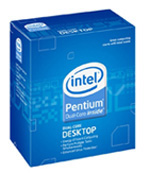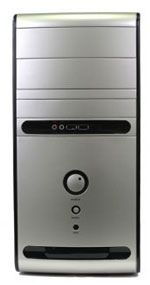Intel Entry-level PC
While Intel still owns the top in the CPU performance, the area from entry to upper midrange is very competitive between Intel and AMD. As pointed out in our Phenom II Guide, the only area still dominated by Intel is the very top, with CPUs at $300 and more. The one advantage that remains for Intel is that their processors generally overclock much better than current AMD CPUs, but that has changed with Phenom II in the midrange. This is not normally a consideration in entry computers, but it could be for some buyers, and at the lowest rungs of the CPU ladder Intel processors remain the best overclockers for now.
| Intel Entry-level PC | ||
| Hardware | Component | Price |
| Processor | Intel Pentium Dual-Core E5200 Wolfdale (2.5GHzx2 65W 2MB L2 800 FSB) |
$73 |
| Cooling | CPU Retail HSF | $- |
| Video | On-Board | $- |
| Motherboard | ECS GF7100PVT-MT NVIDIA GeForce 7100 HMDI | $60 |
| Memory | G.Skill 4GB (2x2GB) DDR2-800 | $37 |
| Hard Drive | WD Caviar GP WD5000AACS 500GB | $59 |
| Optical Drive | Samsung 22X DVDRW/DL SH-S223Q | $25 |
| Audio | On-Board | $- |
| Case | HEC 6K28BSOH48D Micro ATX Mini Tower 485W Power Supply | $50 |
| Power Supply | Included with Case | $- |
| Base System Total | $304 | |
| Display | Hanns-G HB-175APB Black 17" 8ms Widescreen LCD Monitor Built in Speakers - Retail (1440x900) | $99 |
| Speakers | Built-in Monitor | $- |
| Input | Microsoft CA9-00001 Black PS/2 Standard Keyboard and Optical USB/PS2 Mouse - OEM | $16 |
| Operating System | Microsoft Vista Home Premium OEM | $99 |
| Complete System Bottom Line | $518 | |
 |
Our choice for the Intel entry CPU remains the excellent 2.5GHz dual-core E5200 Wolfdale. This 65W rated CPU is built on Intel's 45nm manufacturing that begs you to overclock. The E5200 is rated 800FSB, so right out of the box the first option for overclock, if you are inclined, is to bump it up to a 1066 bus. Even if you never overclock you will be very pleased with the performance of the E5200. The E5200 is an easier choice now that the price is $10 lower at $73 than it was just three months ago. We do not recommend going lower than an E5200 in an Intel system because the trade-offs in performance for the few dollars saved are too great. The E1200 at $50, for example, is dismal compared to the E5200, and certainly not a good choice in performance for the $23 saved.
 |
Unfortunately our favorite Zotac N73PV-Supreme board has been discontinued by Zotac. This was a real surprise considering how well the $60 board sold. The NVIDIA 7100 used in the Zotac is a good chipset choice for an entry Intel 775, so we have chosen the ECS GF7100PVT-MT at the same $60 for the entry Intel system. There is currently a $10 rebate that lowers the price to $50. The ECS provides HDMI output with a DVI to HDMI adapter. If you prefer a real HDMI output on the rear panel you can choose the Gigabyte GA-73PVM-S2H LGA at $69.
 |
The case for the Intel entry system is the solid HEC 6K28BSOH48D Micro ATX mini-tower. HEC is best known as a manufacturer of power supplies. Some are sold under their name, but most are manufactured for other well known power supply brands. HEC includes a 485W PSU with this attractive mini-tower, which should provide plenty of power for your entry Intel build. If you prefer a mid-tower case HEC uses the same PSU in the $50 HEC 6C60BSOH48. You could also choose the Sigma La Vie Aluminum mid-tower featured in the AMD build on the previous page. The rest of the components are virtually identical to the AMD entry-level system.
If we compare the two entry-level systems, the winner depends on what is of value to you. The Intel system is a bit more powerful, but you can move up to a high-end Athlon 64 X2 or a low-end AMD Phenom X3 for comparable performance at less than $100. The full-size AMD ASRock board offers more flexibility for future graphics expansion, with two x16 PCI-E slots and CrossFire X support. If you are a gamer on a strict budget the AMD entry system offers you more for future graphics expansion. For the typical entry-level PC right now and for what the system is typically used for - internet, office, low-end gaming, and low to mid graphics - you can go either route and be very happy.










66 Comments
View All Comments
scwtlover - Monday, March 16, 2009 - link
Thanks. Do you have an opinion regarding the significance of voltage?Wesley Fink - Monday, March 16, 2009 - link
At the same speed or overclock lower voltages that actually work are always better. Higher voltage allows some incredible performance but high voltages shorten component life. If two memories are honestly rated at the same speed and timings but one is lower voltage at that speed, the low voltage is the better choice.There are fewer variations in memory speed, timings, and voltages than you might imagine, though. Almost every memory vendor buys memory chips on the open market. When one company stumbles onto a terrific new chip or PCB it isn't long until most of the major players have the same thing. Expertise in PCB design and SPD programming can matter in performance, but not nearly as much as the actual memory chip and binning used.
scwtlover - Tuesday, March 17, 2009 - link
I apologize for not asking my question more clearly. I understand your general point regarding lower voltages putting less stress on computer parts. I see, however, that while I can get quality 800 DDR2 RAM at 1.8 volts and CAS 5, to get quality 1066 DDR2 RAM at CAS 5, the RAM spec will be 2.0V or even higher. What considerations come into play in making this choice for an AMD system?erple2 - Tuesday, March 17, 2009 - link
By "incredible performance" do you mean that are visible in benchmarks only, or in real world usage?scwtlover - Monday, March 16, 2009 - link
After reading your praise of ASRock's 780GX board for the AMD entry-level system, I was surprised not to find it even mentioned for the AMD budget system. Currently, it's $5 less expensive than the Biostar board you do recommend. As I try to finalize components for my own new build, should I being drawing adverse conclusions about the ASRock 790GX board?MFK - Monday, March 16, 2009 - link
Whats the deal with those these days?I got a cable box for my cable signals but I need my HTPC to act as a DVR.
I think any HTPC should include a TIVO card. Doesn't have to be a TV tuner though!
What would be the cheapest way to add DVR functionality to the HTPCs in the article?
BernardP - Monday, March 16, 2009 - link
All the suggestions are nice and well-balanced. However, monitor choices on the entry-level systems seem questionable. Yes, you have to meet the price point, but these days, it seems 22-inch monitor have become the minimum worth spending money on. Spending on a brand-new 17-inch or 19-inch monitor seems a waste, unless someone has not enough space to fit a larger monitor.The0ne - Monday, March 16, 2009 - link
I agree. 22" LCDs have the sweet spot now. Even the 24"s are coming down in price.Spivonious - Monday, March 16, 2009 - link
Why no tuner in the HTPC? Also, since the 9400 chipset handles all decoding, why use a beefy processor? Also, a 500W power supply is way overkill. 350W would be plenty and probably quieter too.Save $30 on the CPU and go with the E1400.
Other than that, it looks almost exactly like the HTPC I spec'ed for myself last week, only to find out that my bonus was not very big after Uncle Sam got to it.
7Enigma - Monday, March 16, 2009 - link
Did you read the article? They gave an explaination (whether you agree with it or not):[quote]"Since most end-users are on cable or satellite for TV, we will make no recommendations at all for a TV tuner. Of the many possible uses of an HTPC the great majority of end-users store, play, and stream movies with their HTPC computers. That is mostly what their HTPC systems are used for and that is where we have concentrated our recommendations. In general the processing power in both systems has increased since our December 2009 guide, but costs have gone down a bit."
"As we discussed in the HTPC introduction, we did not include a TV tuner in the configuration since most end-users are now using their cable and satellite feeds. Few users, therefore, have any real need for a TV tuner card." [/quote]
As for the beefy processor I somewhat agree with you. If all you are doing is playing movies and such then a lowly cpu is all that is needed due to the mobo. But any form of heavy processing work such as encoding to highly compressed formats, or multitasking while watching a video and it makes sense. Having the better cpu certainly gives you the flexibility to do more than just watch movies.